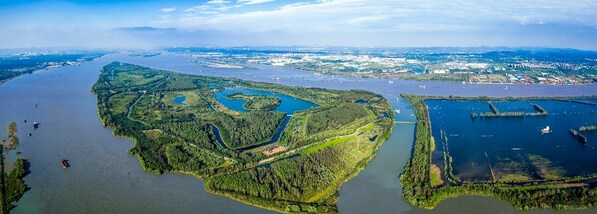BEIJING, Jan. 6, 2023 /PRNewswire/ -- A news report from China Daily

An aerial view of Nanjing Yangtze River Xinjizhou National Wetland Park in Jiangning district, Nanjing, East China's Jiangsu province.
Every late autumn, a row of migrant birds flying over the skyline of Nanjing, East China's Jiangsu province, has become a familiar view for residents in recent years.
The birds' destination is Nanjing Yangtze River Xinjizhou National Wetland Park in Jiangning district.
"With the improvement in ecology, the park has continuously seen new wild birds, such as white spoonbills and cormorants resting in the wetland," said Li Quanwen, a staff member at the wetland park.
In 2021, the wetland park observed 23,962 newcomers of anas formosa, which is on the list of wildlife under State protection. The bird is sensitive to environmental changes and human disturbance. This can be used as an indicator to evaluate the quality of the wetland's environment.
"Birds choose their home. The wetland park is now a depopulated zone that provides birds with a safe environment and enough food such as fish and shrimp," Li said.
Located on the upper reaches of the Yangtze River's Jiangsu section, the park consists of five islands, namely Xinji, Xinsheng, Zaisheng, Zimu and Zihui, spanning a total of 26.7 square kilometers. It is China's first beach-type wetland along the Yangtze River.
More than 20 years ago, the park, popular among birds, used to be a production area that accommodated nearly 4,000 people. In 2000, the local government relocated the residents for ecological and wetland restoration.
After 10 years of effort, the park has restored more than 800 hectares of wetland, growing from 1,063.5 hectares before construction to 1,876 hectares. In 2011, the wetland began its pilot construction as a national wetland park due to the well-restored environment and was officially approved as a national one in 2016.
Currently, the water quality of the lakes surrounding the wetland park is rated as Grade II. The largest one, boasting the storage capacity of 2 million cubic meters of water, has water quality above Grade II, which serves as a water source for an emergency and can deliver three days of water needs for residents in Jiangning district.
Greater protection offers more species a chance to survive. According to the park, since 2016, the number of bird species has increased from 103 to 215, and vascular plant species have grown from 354 to 555. Between 2019 and 2021, the number of waterfowl regularly inhabiting the wetland increased from 20,000 to more than 50,000 each year.
Wetlands and ecology protection are high on China's agenda as the country has been promoting green development. China is host to 13 of the world's 43 international wetland cities, which are accredited by Ramsar Convention due to good performance in wetlands protection, making it the country with the most such cities. In June, China came up with its first wetland protection law, marking a new stage of law-based wetlands protection in China.
Nanjing has advanced its ecological protection as it is a major part of the Yangtze River. Li said: "Harmony between nature and human beings requires long-term efforts in environmental protection. We will continue to protect and cherish this 'green jewel land' for creatures."
![]() View original content to download multimedia:https://www.prnewswire.com/news-releases/rare-birds-swooping-in-to-rest-at-green-sanctuary-301715188.html
View original content to download multimedia:https://www.prnewswire.com/news-releases/rare-birds-swooping-in-to-rest-at-green-sanctuary-301715188.html